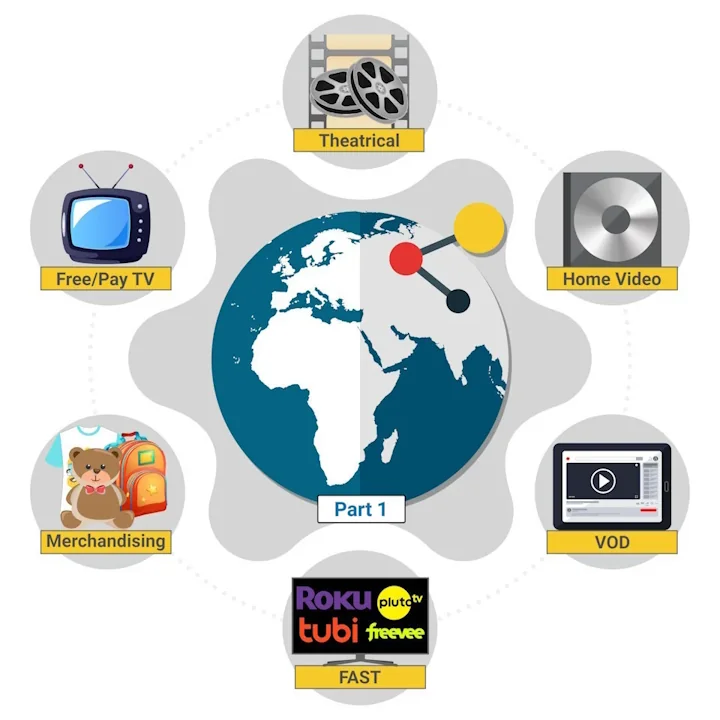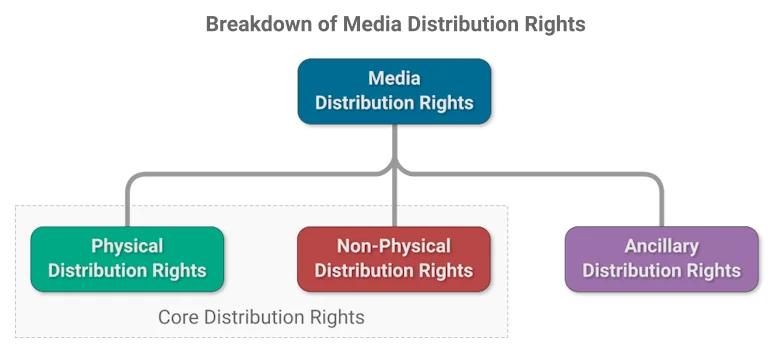A Guide to Traditional and Modern Distribution Rights for Film and TV Content (Part 1)

For filmmakers and producers, the magic doesn’t end with the final cut. Their artistic creation now embarks on a new journey: navigating the intricate landscape of media distribution rights. These rights are the key to unlocking a global audience and propelling a film into the spotlight. They determine how a film will be seen and experienced across various platforms, from the silver screen to streaming services, shaping both its reach and commercial potential.
What are Media Distribution Rights in the Film and TV Industry?
In the film and TV industry, media distribution rights refer to the legal permissions granted by content creators or right holders to individuals or entities for the distribution and exploitation of films and television shows. These rights play a pivotal role in shaping how, where and when a film or TV program can be exhibited and monetized, significantly influencing the dissemination of content to audiences worldwide.
For example, a filmmaker may retain the rights to their film and choose to distribute it independently through various channels, or they may license these rights to distributors specializing in specific markets or platforms.
Understanding media distribution rights is crucial for both producers and distributors. Producers need to know what rights they retain and how they can leverage them to generate revenue. Distributors, on the other hand, need to understand the rights they acquire to ensure they can properly utilize the film in specific territories and platforms.
In essence, a thorough understanding of distribution rights acts as a compass for filmmakers and producers to build their own distribution strategy. It guides them through the labyrinth of distribution options, allowing them to secure favorable deals, optimize revenue streams, and strategically position their films for maximum audience impact.
This series dives into the details of traditional and modern distribution rights, unpacking the ever-expanding options available in today’s dynamic media landscape.
The Categories of Media Distribution Rights
Media distribution rights can be broadly categorized into two main groups:
Core Distribution Rights:
Core distribution rights represent the fundamental rights associated with showcasing a film or TV program. They serve as the foundation upon which content reaches audiences, influencing its initial visibility and accessibility. Indeed, core rights encompass the foundational methods of content dissemination, determining how the content is ultimately shared with viewers. Examples of core distribution rights include theatrical release rights, which enable films to be showcased on the big screen, offering audiences immersive cinematic experiences. Additionally, home video rights allow for the distribution of content through physical formats such as DVDs and Blu-rays, providing viewers with the option to own a personal copy of the film or TV program.Moreover, core distribution rights extend beyond traditional methods to encompass modern avenues of content dissemination. In the digital age, streaming rights have emerged as a pivotal component of core distribution rights, empowering content creators to reach vast audiences worldwide through digital streaming platforms. By securing streaming rights, filmmakers and producers can leverage the convenience and accessibility of on-demand entertainment to connect with viewers on a global scale. Similarly, broadcast rights in the digital realm extend content reach through channels provided by cable or satellite providers, ensuring broader accessibility for viewers who may not yet have fully embraced streaming services. Together, these core distribution rights pave the way for content creators to share their creations with audiences across diverse platforms and mediums, maximizing their reach and impact in the ever-evolving landscape of entertainment distribution.
Ancillary Distribution Rights:
While core distribution rights focus on the primary methods of bringing a film or TV program directly to audiences, ancillary distribution rights offer content creators additional avenues for revenue generation. These rights provide diverse opportunities to capitalize on the popularity and appeal of their content through supplementary channels. For instance, merchandising rights allow for the creation and sale of products inspired by the film or TV show, ranging from action figures to toys and apparel. This extends the brand’s presence beyond the screen and fosters tangible connections with fans. Similarly, soundtrack licensing enables the use of music featured in the content for commercials, video games and other media projects, expanding the reach of the content while generating additional revenue through licensing fees.

Understanding Core Distribution Rights
As previously discussed, core distribution rights form the cornerstone of your content’s distribution strategy, determining how the core content - the film or show itself - is presented to audiences. Moreover, these rights are divided into two main categories, each offering distinct approaches to dissemination:
Physical Distribution Rights:
Physical distribution rights encompass traditional channels that rely on tangible media, hence the term ‘physical’ reflecting the tangible nature of the distribution process. Theatrical releases offer audiences immersive cinematic experiences in cinemas worldwide, while physical home video distribution involves the sale and rental of DVDs and Blu-rays through various outlets. Nevertheless, as digital technologies advance, these methods are gradually losing prominence as audiences favor digital platforms. Despite this shift, physical distribution maintains relevance for specific demographics and regions.Non-Physical Distribution Rights:
In contrast, non-physical distribution rights encompass networks and platforms that deliver content without the need for physical media, primarily through digital channels. These rights are deeply rooted in modern technologies and cater to the evolving preferences of contemporary audiences. Television distribution involves licensing films to free and pay broadcast networks or cable channels for scheduled airing, while video-on-demand (VOD) platforms offer on-demand access to an extensive library of films and TV shows. Moreover, modern home video distribution facilitates digital rentals and purchases through various digital platforms. This digital landscape provides unparalleled convenience and accessibility, reflecting the changing dynamics of content consumption in the digital age.
To conclude the first part of this series, we’ve explored the fundamental concepts of core and ancillary distribution rights, shedding light on their significance in the world of filmmaking and content distribution. In the upcoming articles, we will provide comprehensive insights into each category, offering detailed analysis of distribution strategies. Stay tuned as we continue to uncover the complexities of distribution rights.
Visit our website or contact us today to learn more about how MediaRights can empower your business.

